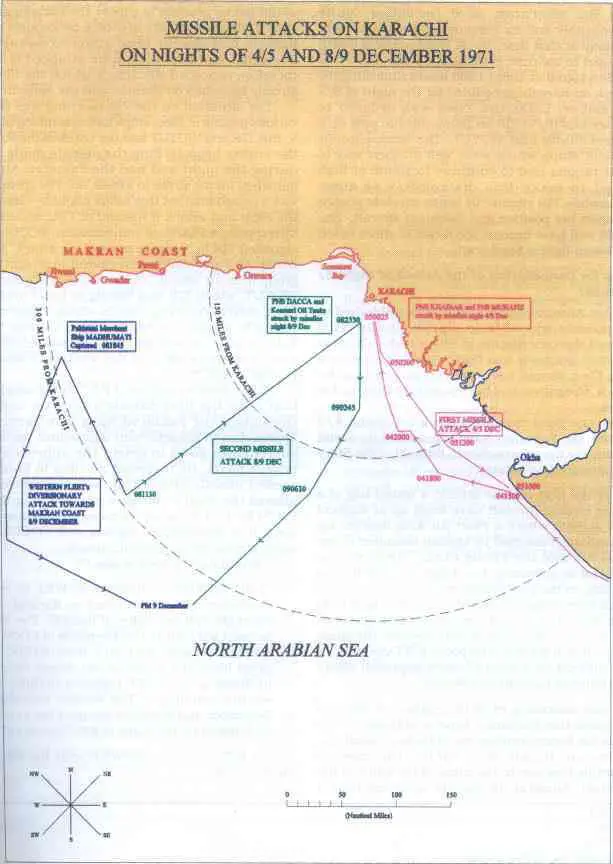With the entire fleet based in Karachi harbour, the port of Karachi housed the headquarters of the Pakistan Navy back in 1971 while a blockade would be disastrous for Pakistan economy as the city was also one of the hubs of Pakistan’s Maritime trade, according to sources. Being defended heavily against any type of air or Naval strikes the security of Karachi Harbour was predominant to the Pakistani High Command while on the other hand the port’s airspace was also secured by the strike aircraft based at airfields in the area.
Tensions rose between India and Pakistan towards the end of 1971 when three Vidyut class missile boats were deployed by the Indian Navy after Pakistan declared a national emergency on 23rd November, with an intention to carry out patrols, the Indian Navy had deployed the boats in the vicinity of Okha near Karachi. However, a demarcation line was been set up by the Indian Navy as the Pakistani fleet would also be operating in the same waters and the line which was set by the Indian Navy was not to be crossed by any of their ships in the fleet. That said, the indo-Pakistani war of 1971 officially began on 3rd December after Pakistan attacked Indian airfields along the border.
Loading the Guns
It so happened that it was planned by the Indian naval headquarters situated in Delhi along with the Western Naval Command to attack the port of Karachi, while for the same, a strike group under the Western Naval Command was also formed, according to official reports. This particular strike group was to be based around the above-cited three Vidyut class missile boats which were already deployed off the coast of Okha.

It was decided that support vessels would be assigned to the group as these boats had limited operational and radar range.
Designated as the Karachi Strike Group was formed on 4th December which consisted of the three Vidyut class missile boats including INS Veer, INS Nipat and INS Nirghat each armed with four Soviet-made SS-N-2B Styx surface to surface missiles which were equipped with a range of 40 nautical miles along with a fleet tanker INS Poshak and two Arnala class anti-submarine Corvettes namely INS Katchall and INS Kiltan.
Triggers pulled
During the day, on 4th December, the decided positions were maintained by the Strike Group after reaching 250 nautical miles south off the coast of Karachi, outside the surveillance range of the Pakistan Air Force. It was planned that the attack would take place between dusk and dawn as the Pakistani aircraft did not possessed any night-bombing capabilities. The Indian task group moved around 180 nmi from its position towards the south of Karachi at 10:30 pm Pakistan Standard Time. Soon the Pakistani targets, identified as warships, according to sources, were detected.
INS Nirghat fired its first Styx missiles at PNS Khaibar (a Pakistani Battle-class destroyer) after the ship drove forward in a northwesterly direction. Anti-aircraft systems were been engaged by Khaibar assuming that it was a missile from an Indian aircraft while exploding below the galley in the electrician’s mess deck at 10:45 p.m., the Missile hit the right side of the ship which led to an explosion in the first boiler room.

The ship was flooded with smoke and it lost its propulsion, with that, an emergency signal was sent to the Pakistani Naval Headquarters. However, the signal contained the wrong coordinates of the ship’s position due to the Chaos created by the explosion which in turn delayed the rescue teams from reaching its location. On the other hand, Nirghat fired its second missile which hit Khaibar in the second boiler room on the ship’s starboard side eventually resulting in the sinking of the ship and claiming the lives of 222 sailors.
Around 11 p.m. two missiles were fired by INS Nipat one each at the cargo vessel MV Venus Challenger along with its escort PNS Shah Jahan after verifying two targets in the area Northwest of Karachi. After the Missile was hit, the Venus Challenger exploded immediately while it was carrying ammunition for the Pakistani forces and eventually sank 23 nmi south of Karachi. In the meanwhile, PNS Shah Jahan was targeted and damaged by another missile and around 11:20 p.m. PNS Muhafiz was targeted by INS Veer. Muhafiz sank immediately after a missile was struck on the left side behind the bridge thereby killing 33 sailors.
The Kemari oil storage tanks were targeted in the meanwhile by INS Nipat which fired two missiles, one of which hit the oil tanks resulting in complete destruction and causing a Pakistani fuel shortage. After this, the task force returned to the nearest Indian ports.
Aftermath
By bombing the Okha port the Pakistan Air Force retaliated for these attacks scoring direct hits on fuelling facilities for missile boats, missiles Boat Jetty and an ammunition dump but the Indian Navy had already anticipated this attack and had moved the Missile boats to some other locations in order to prevent any losses.
A number of false alarms in the ensuing days about the presence of the Indian Navy vessels off Karachi were raised by the deployments while all of the Pakistan and forces were put on high alert as a result of the operation.
This Friendly fire was complementary
On 6th December 1971, a frigate of the Pakistan Navy was incorrectly reported as an Indian Navy missile boat by the friendship reconnaissance aircraft. Pakistan Air Force airstrike on the supposed Indian ship was requested by the Pakistan Navy headquarters and The vessel was scrambled and strafed by the fighter jets before it was identified as the frigate PNS Zulfiqar.
